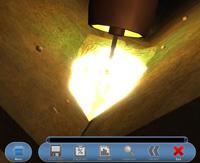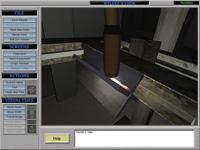Senior Editor
- FMA
- The Fabricator
- FABTECH
- Canadian Metalworking
Categories
- Additive Manufacturing
- Aluminum Welding
- Arc Welding
- Assembly and Joining
- Automation and Robotics
- Bending and Forming
- Consumables
- Cutting and Weld Prep
- Electric Vehicles
- En Español
- Finishing
- Hydroforming
- Laser Cutting
- Laser Welding
- Machining
- Manufacturing Software
- Materials Handling
- Metals/Materials
- Oxyfuel Cutting
- Plasma Cutting
- Power Tools
- Punching and Other Holemaking
- Roll Forming
- Safety
- Sawing
- Shearing
- Shop Management
- Testing and Measuring
- Tube and Pipe Fabrication
- Tube and Pipe Production
- Waterjet Cutting
Industry Directory
Webcasts
Podcasts
FAB 40
Advertise
Subscribe
Account Login
Search
Virtually welding
Training in a virtual environment gives welding students a leg up
- By Tim Heston
- March 11, 2008
- Article
- Arc Welding
A recent study led to an odd conclusion: Playing video games may produce better surgeons.
Really, it's true, at least according to researchers at the Banner Health Center in Phoenix. They had surgical residents play games on the Nintendo® Wii™ console before simulated surgeries. Games such as Marble Mania require precise hand movements of the Wii's wireless wand, movements that seem to prep these residents for the hand movements surgery requires.
In a certain light, welding resembles surgery, with careful hands "stitching up" metal instead of skin, and today several companies offer technologies that help beginning welders get that hand motion just right.
None claims that the technology will replace the real thing, of course, but they do say that training in the virtual world can give students a significant leg up by the time they weld for the first time. It helps teach students what really happens between the welding arc and workpiece, why certain hand motions produce good beads while other motions don't. And it also may help introduce welding to students who wouldn't have given the trade a second thought.
It boils down the art of welding into a science, and according to the simulation designers, they have hopes of conveying that science to a new generation of welders.
Three Approaches
Welding simulation development started in earnest during the past decade in three countries: the U.S., Canada, and France. Teams in each country tackled the challenge differently, and each emerged with its own technologies, but all have the same overarching goal: to make weld training more effective.
Claude Choquet, president of 123Certification Inc. in Montreal, is a welding engineer who has focused his research on the simulation of manual and semiautomatic processes. The company's arc+® simulator, first implemented fully in 2006, depicts a virtual environment through 3-D glasses inside a welding helmet (seeFigures 1 and 2). Seven years in development, the system tracks the gun motion through special markers, similar to those used for surgery simulations, along with "spatial metrology that locates a 3-D object in space," Choquet said. "It involves motion tracking, metallurgical processing [of the bead characteristics], and 3-D image rendering.
"The welder sees the arc itself, the weld pool, and the first wave of solidification," Choquet continued. The welder even sees a simulation of fume (virtual, of course, so impossible to breathe). After welding, the system gives a diagnostic report showing the welder's manual dexterity, travel angle, root penetration, and other characteristics.
Across the Atlantic, a French vocational training organization had the idea of virtual welding training, and in 2001 it contracted with CS, a French conglomerate. By 2003 the company had developed its first prototype. Dubbed CS WAVE, the technology differs from arc+ in that it doesn't use a welding helmet and the welding action happens on a screen that can be moved into the horizontal or flat position. The welding gun uses gyroscopic and ultrasonic technology to detect position. The student simulates welding motion by moving the gun across the simulated, on-screen weld joint (seeFigure 3).
Although the company considered so-called "immersion" virtual reality technology, it decided to go the on-screen route "because we wanted something that was easy, something durable enough for welding shops," said CS WAVE's Laurent Da Dalto, based in Toulouse.
During the past year, in fact, CS has been negotiating to team up with 123Certification to market simulators under one common product line—a logical step, according to Da Dalto and Choquet, with both companies sharing complementary expertise about the technology.
In the U.S., the impetus for a virtual welding system came from the Navy Joining Center, managed under the auspices of the Edison Welding Institute in Columbus, Ohio. The government, through the Navy Manufacturing Technology (ManTech) Program, provided funds to develop a virtual welding system, originally for training employees at General Dynamics Electric Boat Corp.
The company's repair welders had a conundrum: When a ship comes in to port for maintenance, they have only one shot to get the weld right. "So, they thought,"Wouldn't it be cool if these welders could practice before the ship docked?'" said Nancy Porter, EWI project manager.
The project set the stage for initial development. EWI teamed up with VRSim, an East Hartford, Conn.-based firm that until that time had focused its efforts on virtual reality training for prototyping and maintainability studies. For engineers at both organizations, welding proved to be an entirely different animal. The software code had to balance material properties with the heat from the arc, as well as the overall weld parameters—not a simple task, and it took three computer processors to sift through all the data.
The project's first phase focused primarily on whether a machine could accurately simulate welding graphically in a virtual environment. After success, by about 2005, with ManTech money running out, VRSim took the reins to see if it could develop a marketable product.
"The NJC [project] showed some real promise, but it's vastly different than [what we have today]," said VRSim President Matthew Wallace. "It was a little more sophisticated in its outward presentation … but the system would have retailed for about $300,000."
Some of the initial challenges in developing a marketable product, Wallace said, involved differing training practices among companies. "We assumed the proper way to weld was like a golf swing," he said—taught somewhat the same way everywhere.
But that's not so with welding. Different applications have different needs, he said, and therefore slightly different welding techniques. At Electric Boat, for example, welders go "straight in and straight out of a weld joint," he said. "It's very different," and the simulation had to account for those differences. A shop may use different weld guns, different wires, and so on, and the weld simulation had to account for these variables.
What resulted used the ManTech information as a foundation, but it was less expensive and required less computing power, using off-the-shelf duo-core processors. As Wallace explained, the product now uses proprietary mesh simulation techniques rooted in fluid dynamics and experiential data.
Working off this software, the system can give a student a virtual welding experience, minus the heat and metal. The welder puts on a helmet with glasses that connect with the virtual reality software. The welder then picks up a welding gun that has sensor arrays that measure the gun's position. Moving along plastic mockups of weld joints, the student sees a virtual arc lay down a virtual bead (see Figures 4 and 5).

Figure 3A technician demonstrates the CS WAVE system, which simulates the resulting weld on a screen.
"We call it"augmented' reality," Wallace said. "We're incorporating the real welding gun with the same weight and feel that a welder would have for a real GMAW process, and matching it with horizontal T joints, vertical-up, open butt—the 20 percent [of weld geometries] that represents 80 percent of welds."
Why Go Virtual?
Earlier this year Wallace got a call from the California penal system. Officials there needed a way to train inmates to increase their chances of employment after they get out. A consistent, relatively well-paying job gives ex-prisoners good incentive to stay out of jail for good, and welding could provide such a career. But the thermal process presents obvious security concerns, so penal system officials think a virtual system could help.
Still, debate continues as to how useful these virtual training systems are. Yes, they may help California inmates, but what about applications for the typical technical college or company training program, particularly with the high upfront cost, compared to a typical welding machine?
According to Ken Smith of Lorain County Community College, Elyria, Ohio, a virtual system could have a lot of potential, attracting students who may not have considered welding before. Yes, the upfront cost is high, but he also mentioned the cost savings—no consumables, no scrap metal—as well as the legal benefits. "There's the liability you don't have to worry about," he said. Virtual processes emit no welding fume or heat.
It's precisely that lack of heat, fume, and other real characteristics that raises concern among some. This is why all stakeholders in virtual systems claim that while their products complement or augment real-world training, they don't replace it.
Wallace related a story of one of his programmers who attended the last FABTECH & AWS Welding Show. After spending hours trying out the company's simulator, he picked up a welding gun—this one connected to a real power source—and was able to lay down a very respectable bead, especially for someone who had never welded. Was he at a professional level? Certainly not, Wallace said, but he was much farther down the training path than the average beginner.
As Wallace put it, virtual weld systems can augment training in two ways. First, they can help a student welder, weld technician, or supervisor being trained in various positions and processes gain greater insight into welding technology and how specific gun motions affect bead quality.
Second, they can help train nonwelders to weld very specific parts, expanding an employee's skill set. For instance, an assembler or press brake operator could learn to weld a specific joint on a certain product. As Wallace explained, using the product's CAD model, a virtual weld system could allow that worker to perfect the motion needed for a specific weld joint, again and again, before practicing on the real thing. With such training, the press brake operator could move over to the weld station as needed.
Sources also suggested that a virtual trainer might attract more of the "video game" generation to the field. (For instance, VRSim offers a simulation that puts welders in the pit of a stock car race.) The simulations emphasize the dexterity and science involved, minus the heat. It's about making precise motions of the weld gun to match the workpiece material, thickness, and geometry; it's not all arcs and sparks. This, they said, gives welding a different image.
"Virtual technology is something that's associated to video games," explained CS WAVE's Da Dalto. "But you now see more applications in"serious' games, including those used by the military, and other applications including oil exploration and weather forecasting." Taking virtual reality to the welding arena represents a natural progression, he said.
"Most people who learn welding and stick with it for six months … tend to stay in it for a lifetime," Wallace said. "It helps to get people to stay if [during training] you can't burn yourself.
"It's about learning through repetition," Wallace continued, explaining that through these "reps" students can practice travel speed, gun angle, electrode extension, and other variables before operating a real weld gun.
Another plus: The virtual machines give immediate reports that show what a student did incorrectly and where, allow an instructor to give objective feedback, and, most important, tell a student exactly why and when a weld defect occurred (see Figure 6). The instructor also can program the system to isolate variables, to help students home in on a specific problem.
"The technology enables a self-directed practice, with instant replays and instant feedback for the learner, and detailed reports generated for the instructors," 123Certification's Choquet explained. "It gives a second-by-second feedback, with visual updates of the welding parameters, which then can be looked at after the fact and then analyzed." He added that diagnostics reveal feedback regarding a welder's manual dexterity, as well as the quality of the virtual weld bead. "And both are related. For instance, if you don't have the proper travel angle, your root penetration will not be adequate."
The technology also helps correct some bad habits. For instance, one company used a virtual system to correct an error involving a flux-cored process. The welders, though, had originally been trained in shielded metal arc welding. As Choquet explained, these welders used a virtual weld trainer, which detected that they were in fact pushing the electrode along the weld joint, as they would with a stick electrode. This flux-cored process, however, required that they pull the weld gun along the joint—and the virtual trainer helped the welders correct the problem.
Choquet added another benefit of virtual training: Without any consumables, "the pre- and postweld time consumption is cut by a factor of 10."
Wallace added that virtual systems also have potential for learning how to weld very expensive material—titanium, INCONEL® alloys, and the like—without having to buy the material.
Another potential involves distance learning. "It's entirely possible to work with the simulator in a remote environment," Wallace explained, by sending reports back to a trainer who could be hundreds or thousands of miles away. Just recently Wallace installed portable welding systems in a rural Alaska school district. The state desperately needs welders, but it wouldn't be practical to hire a full-time weld instructor to teach only a few students in remote regions. Here, virtual training filled a need.
How Far to Push Virtual
Virtual welding systems remain a technology in infancy, and as with any new technology, debate is swirling about how it should be used. Choquet's company, for instance, has offered its virtual system to qualify welders.
Welders at a truck assembly plant north of Montreal had never been through a qualification with radiographic examination. "But from the simulation, they learned how to properly locate the welding gun to perform this qualification," Choquet said. "The result was so positive that the company decided not to continue with traditional welder tests. The [virtual] diagnostics were sufficient for their quality control department."
But how far should virtual systems go? Could they be used to prove out processes; to help power source suppliers develop next-generation products; to simulate robotic welding cells? At present there's a laundry list of possibilities, but the current offering focuses primarily on education and training.
And in the training arena, virtual reality's impact could be the most dramatic. "My personal opinion is that it should be in every vocational school and anyplace with a welding classroom, where the focus is on teaching welding," EWI's Porter said. "The ideas are limitless."
About the Author

Tim Heston
2135 Point Blvd
Elgin, IL 60123
815-381-1314
Tim Heston, The Fabricator's senior editor, has covered the metal fabrication industry since 1998, starting his career at the American Welding Society's Welding Journal. Since then he has covered the full range of metal fabrication processes, from stamping, bending, and cutting to grinding and polishing. He joined The Fabricator's staff in October 2007.
Related Companies
subscribe now

The Fabricator is North America's leading magazine for the metal forming and fabricating industry. The magazine delivers the news, technical articles, and case histories that enable fabricators to do their jobs more efficiently. The Fabricator has served the industry since 1970.
start your free subscription- Stay connected from anywhere

Easily access valuable industry resources now with full access to the digital edition of The Fabricator.

Easily access valuable industry resources now with full access to the digital edition of The Welder.

Easily access valuable industry resources now with full access to the digital edition of The Tube and Pipe Journal.
- Podcasting
- Podcast:
- The Fabricator Podcast
- Published:
- 04/16/2024
- Running Time:
- 63:29
In this episode of The Fabricator Podcast, Caleb Chamberlain, co-founder and CEO of OSH Cut, discusses his company’s...
- Industry Events
16th Annual Safety Conference
- April 30 - May 1, 2024
- Elgin,
Pipe and Tube Conference
- May 21 - 22, 2024
- Omaha, NE
World-Class Roll Forming Workshop
- June 5 - 6, 2024
- Louisville, KY
Advanced Laser Application Workshop
- June 25 - 27, 2024
- Novi, MI




































